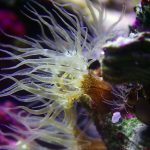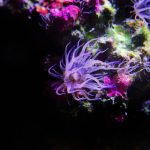Aiptasia is a type of sea anemone that can cause problems for those who keep saltwater aquariums. These anemones are known for their ability to reproduce rapidly and for their tendency to compete with other corals for food. Additionally, they can sting their neighbors and be very difficult to eradicate once they have established themselves in a tank.
Despite their small size, Aiptasia can have a big impact on the health of a saltwater aquarium. They can spread quickly and take over a tank, causing damage to other corals and even killing them. Because of this, it is important for aquarium owners to be able to recognize and deal with Aiptasia infestations quickly and effectively.
There are several methods that can be used to eliminate Aiptasia from a tank, including chemical treatments and manual removal. However, prevention is often the best approach. By taking steps to maintain a healthy and balanced aquarium environment, owners can reduce the risk of Aiptasia infestations and keep their tanks looking beautiful and thriving.
-What is Aiptasia?
-How to Identify Aiptasia
-Methods of Aiptasia Control
-Preventing Aiptasia Infestations
What is Aiptasia?
Aiptasia is a type of invasive sea anemone that is commonly found in saltwater aquariums. It is known for its fast-spreading nature and aggressive behavior, making it a common pest among aquarium enthusiasts. Aiptasia anemones can be identified by their long, stinging tentacles and clear or brownish body coloration.
There are around a dozen species of Aiptasia, all of which can cause problems in a saltwater aquarium. They are opportunistic creatures that can quickly monopolize a tank, competing for food and space with other corals and organisms. Aiptasia can also sting their neighbors, causing damage to other creatures in the aquarium.
It is important to remove Aiptasia as soon as it is detected in an aquarium to prevent infestations. Removal methods can include physical removal, chemical treatments, and biological control.


How to Identify Aiptasia
Aiptasia is a type of sea anemone that is commonly found in saltwater aquariums. They are known for their ability to reproduce rapidly and can quickly become a pest if left unchecked. Here are some ways to identify Aiptasia:
Physical Characteristics
Aiptasia looks like a small yellow, brown, or colorless coral. It has a stalk with a head like a sunflower with tentacles coming out. They can first appear small but grow to over 2″ tall. Once mature they can reproduce rapidly as they move and leave tissue behind to grow into another stalk.
These opportunistic anemones can be identified by their resemblance to miniature palm trees, with a polyp body and an oral disc bordered by tentacles. There are many different species of Aiptasia; some varieties are transparent, while others are mostly light brown or tan in color, ranging in size from a few centimeters to a few inches.
Behavior
Aiptasia is known for its aggressive behavior and can sting other corals in the aquarium. They are opportunistic feeders and can consume small organisms like copepods and amphipods. They are also known to consume leftover food and other organic matter in the aquarium.
Aiptasia can reproduce both sexually and asexually. They can release eggs and sperm into the water column, which will fertilize and create larvae. The larvae will settle on a surface and create a new Aiptasia colony. They can also reproduce asexually by budding, where a new Aiptasia polyp will grow from the parent polyp.
It is important to identify Aiptasia early on and take action to prevent them from spreading in the aquarium. Aiptasia can be difficult to remove once established, so it is best to take preventative measures such as quarantining new corals and monitoring the aquarium for signs of Aiptasia.

Methods of Aiptasia Control
Aiptasia, also known as glass anemones, can quickly become a nuisance in a reef aquarium. Fortunately, there are several methods for controlling and eliminating these pests.
Natural Predators
One effective method for controlling Aiptasia is to introduce natural predators into the aquarium. Peppermint shrimp, hermit crabs, and sea slugs from the Berghia genera are all known to feed on Aiptasia. These invertebrates can be a great option for those who prefer natural and chemical-free methods of control.
Chemical Treatments
There are several chemical treatments available for eliminating Aiptasia. Products such as Aiptasia X from Red Sea, Joe’s Juice, and the Majano Wand are designed specifically for this purpose. These products work by killing the Aiptasia on contact. However, they may require multiple applications to fully eliminate the infestation.
Physical Removal
Physical removal of Aiptasia can be done using a variety of methods. One method involves injecting scalding hot RO water into the polyp with a hypodermic needle. Lemon juice may also be used to inject the Aiptasia. Another method involves using a tool such as the Majano Wand to physically remove the Aiptasia from the aquarium.
Electrical Methods
Electrical methods can also be effective for eliminating Aiptasia. The use of a low voltage electrical current can kill the Aiptasia without harming other inhabitants in the aquarium. However, this method should only be attempted by experienced aquarists.
Biological Treatments
Biological treatments involve the use of beneficial bacteria to eliminate Aiptasia. One such product is called Aiptasia-Eating Filefish. These fish are known to feed on Aiptasia and can be a great addition to a reef aquarium. However, it is important to note that these fish may also eat other types of polyps and should be used with caution.
Preventing Aiptasia Infestations
Quarantine Procedures
One of the most effective ways to prevent an aiptasia infestation is to quarantine all new corals and invertebrates before introducing them to the main tank. This allows you to inspect them for any signs of aiptasia or other pests before they have a chance to spread.
When quarantining new specimens, it is important to keep them in a separate tank or container that is free of aiptasia and other pests. The water in the quarantine tank should also be free of any contaminants or pollutants that could harm the new arrivals.
Quarantine periods can vary depending on the size and type of the specimen, but a minimum of two weeks is recommended to ensure that any pests or diseases are identified and treated before introducing the new arrivals to the main tank.
Proper Tank Maintenance
Proper tank maintenance is also crucial in preventing aiptasia infestations. This includes regular water changes, maintaining proper water chemistry, and ensuring that any new additions to the tank are thoroughly cleaned and inspected before being introduced.
It is also important to remove any dead or dying coral or invertebrates from the tank as soon as possible, as these can attract pests and contribute to poor water quality.
In addition, it is recommended to avoid overfeeding the tank, as excess food can contribute to poor water quality and create a breeding ground for pests like aiptasia.
By following these quarantine procedures and maintaining proper tank maintenance, hobbyists can significantly reduce the risk of aiptasia infestations in their reef tanks.
FAQ’s
Here are some frequently asked questions about aiptasia:
What is aiptasia?
Aiptasia is an invasive species of coral that is one of the most common pests in a saltwater aquarium. It can spread rapidly, compete against other corals for food, sting its neighbors, and can be very tough to eradicate. Removal when it first appears is the best chance to prevent infestations.
How do you identify aiptasia?
Aiptasia can be identified by its long, thin, translucent tentacles and its tube-like body. It can be difficult to spot because it can blend in with live rock and other corals. Aiptasia can also reproduce quickly, so it is important to remove it as soon as possible.
What are some natural ways to control aiptasia?
There are several natural ways to control aiptasia, including introducing aiptasia-eating organisms like peppermint shrimp, filefish, and butterflyfish into the aquarium. Another natural method is to use aiptasia-killing products like lemon juice, vinegar, or boiling water. However, caution should be exercised when using these methods as they can harm other inhabitants of the aquarium.
What are some chemical methods to control aiptasia?
Chemical methods to control aiptasia include using products like Aiptasia-X, JoesJuice, and Kalkwasser paste. These products are specifically designed to kill aiptasia without harming other inhabitants of the aquarium. However, it is important to follow the instructions carefully and to avoid overdosing the aquarium.
How can aiptasia be prevented?
Aiptasia can be prevented by practicing good aquarium maintenance, including regular water changes, cleaning the aquarium equipment, and avoiding overfeeding. Quarantining new additions to the aquarium can also help prevent the introduction of aiptasia and other pests.
